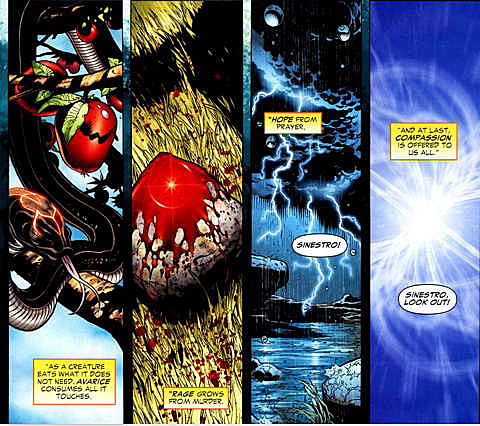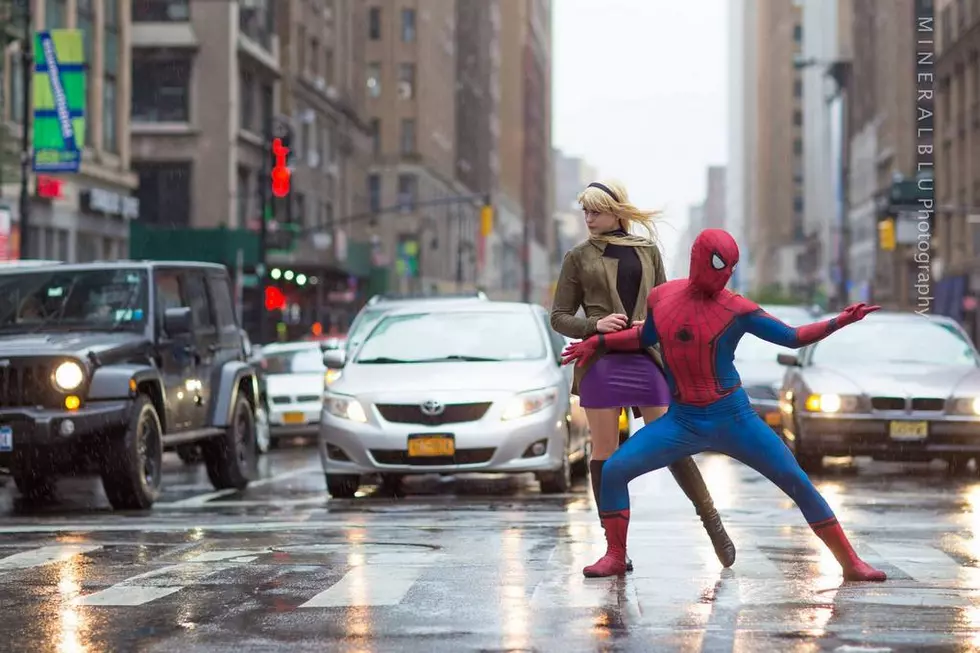
Deconstructing the Massive Biblically-Inspired White Lantern Cover Art

The DC Comics Source blog has just released the combined image of the White Lantern variant covers by Ryan Sook, who previously blew us away with his work on "Kamandi" in "Wednesday Comics." The image features the heroes involved in The Labors of the Twelve, the twelve heroes and villains revived by the White Entity, and given a specific task to complete before they can completely live again. The twelve heroes are featured in a circular way that seems to suggest the art of the Sistine Chapel, in front of a scene that represents the origin stories of the entities of the Lantern Spectrum -- stories that may tie into the origin story of life itself, as described in the Bible.
See the full image, and some possible interpretations of the DC (and religious) mythology involved after the jump.
In "Green Lantern" #42 when Sinestro becomes the White Lantern, he sees the origin of the Emotional Spectrum stretching back to the beginning of life itself, where the white light enters the universe, and during the primordial stirrings of the Earth "the first sentient creature in the universe to ever will itself to move... do[es] just that. And it is the origin of willpower itself."
Which means both that the Earth is the origin of all life in the DC Universe -- which is populated by more than a few alien life forms -- and that the willpower of the Green Lantern is the first light of the spectrum to emerge. The second is fear, generated by the survival instincts of early creatures giving birth to the yellow light, Parallax.

Love appears in what may be the Garden of Eden with Adam and Eve -- along with Predator, the emotional entity of the violet light possessed by the Star Sapphires. Avarice emerges shortly thereafter in the form of a snake surrounded by apples, an obvious allusion to Eden, and Rage follows with the first murder -- perhaps the murder of Abel by Cain, the sons of Adam and Eve in the Bible.
Hope appears during a great flood -- an echo of the story of Noah and his ark, but one that is reflected in numerous flood or deluge myths around the globe. Finally, Sinestro explains, "compassion is offered to us all," a statement that in a Christian context evokes the coming of Christ and the forgiveness of sins. The embodiment of the indigo light of compassion, however, more closely resembles a cephalopod, which is not to say that I would not welcome the saving grace of Squid Jesus, praise be His name. The ways of the Lord are truly mysterious.

In the image by Sook, we see these themes echoed again, moving right to left with the first stirring of willpower through Ion, the fear of Parallax winding again through a garden full of apples where an orange entity -- presumably Ophidian -- is partially obscured. Interestingly, we see the Predator here literally in the midst of fear, as its snake-like appendage curls around it. These two always seem to follow closely after each other, perhaps with the implication that there is no love without fear -- no attachment without a resulting terror of losing what you care about.
The rest of the entities play out in the same order as detailed by Sinestro: rage, hope, and compassion. The progression is capped on either side by figures representing the black and white entities. A black hooded figure stands on the left, while on the right, the white light embodiment of the Entity -- who looks eerily like Iron Man with Archangel wings -- is also wearing a literal halo and clearly evoking an angel. The cloud-like hand reaching forth is likely the hand of creation that was originally seen by Krona when he dared to look backwards into the moment when the universe began.
Oddly, it appears to be coming out of Nekron, the embodiment of death who was responsible for the creation of the Black Lantern rings, although that may suggest simply nothingness, the absence of emotion or life -- or anything -- that preceded creation. With Nekron on one end and the hooded figure on the other, the Black Lanterns appearing to be bookending the image, meaning there is nothingness on either end on the story it tells, either about these characters, or the Lanterns, or life itself..
Another question is whether the placement of the heroes above and below particular entities/colors/lights has any significance either to their characters or their Labors. Maxwell Lord and Hawk are clearly beside the White Entity, while Aquaman is placed beneath Nekron. Other pairings include Firestorm and Ion (green), Osiris and Parallax (yellow), Professor Zoom and The Predator (violet), Hawkman and Ophidian (orange), Hawkwoman and The Butcher (red), Jade and Adara (blue), Captain Boomerang and Martian Manhunter next to Proselyte (indigo), and Deadman (black).
Any other interpretations of what's going on in the art?
More From ComicsAlliance










